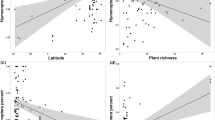Abstract
A recently discovered feature of plant–flower visitor webs is the asymmetric specialization of the interaction partners: specialized plants interact mainly with generalized flower visitors and specialized flower visitors mainly with generalized plants. Little is known about the factors leading to this asymmetry and their consequences for the extinction risk of species. Previous studies have proposed random interactions proportional to species abundance as an explanation. However, the simulation models used in these studies did not include potential biological constraints. In the present study, we tested the potential role of both morphological constraints and species abundance in promoting asymmetric specialization. We compared actual field data of a Mediterranean plant–flower visitor web with predictions of Monte Carlo simulations including different combinations of the potential factors structuring the web. Our simulations showed that both nectar-holder depth and abundance were able to produce asymmetry; but that the expected degree of asymmetry was stronger if based on both. Both factors can predict the number of interaction partners, but only nectar-holder depth was able to predict the degree of asymmetry of a certain species. What is more, without the size threshold the influence of abundance would disappear over time. Thus, asymmetric specialization seems to be the result of a size threshold and, only among the allowed interactions above this size threshold, a result of random interactions proportional to abundance. The simulations also showed that asymmetric specialization could not be the reason that the extinction risk of specialists and generalists is equalized, as suggested in the literature. In asymmetric webs specialists clearly had higher short-term extinction risks. In fact, primarily generalist visitors seem to profit from asymmetric specialization. In our web, specialists were less abundant than generalists. Therefore, including abundance in the simulation models increased the difference between specialists and generalists even more.





Similar content being viewed by others
References
Aizen MA, Ashworth L, Galetto L (2002) Reproductive success in fragmented habitats: do compatibility systems and pollination specialization matter? J Veg Sci 13:885–892
Ashworth L, Aguilar R, Galetto L, Aizen MA (2004) Why do pollination generalist and specialist plant species show similar reproductive susceptibility to habitat fragmentation? J Ecol 92:717–719
Atmar W, Patterson BD (1993) The measure of order and disorder in the distribution of species in fragmented habitat. Oecologia 96:373–382
Bascompte J, Jordano P, Melian CJ, Olesen JM (2003) The nested assembly of plant–animal mutualistic networks. Proc Natl Acad Sci USA 100:9383–9387
Corbet SA (2006) A typology of pollinations systems: implications for crop management and the conservation of wild plants. In: Waser N, Ollerton J (eds) Plant–pollinator interactions: from specialization to generalization. The University of Chicago Press, Chicago, pp 315–340
Dicks LV, Corbet SA, Pywell RF (2002) Compartmentalization in plant–insect flower visitor webs. J Anim Ecol 71:32–43
Dupont YL, Hansen DM, Olesen JM (2003) Structure of a plant–flower-visitor network in the high-altitude sub-alpine desert of Tenerife, Canary Islands. Ecography 26:301–310
Ferry-Graham LA, Bolnick DI, Wainwright PC (2002) Using functional morphology to examine the ecology and evolution of specialization. Integr Comp Biol 42:265–277
Gotelli NJ, Graves GR (1996) Null models in ecology. Smithsonian Institution Press, Washington
Hood GM (2005) PopTools version 2.6.6. Available on the internet. URL http://www.cse.csiro.au/poptools
Jordano P, Bascompte J, Olesen JM (2003) Invariant properties in coevolutionary networks of plant–animal interactions. Ecol Lett 6:69–81
Jordano P, Bascompte J, Olesen JM (2006) The ecological consequences of complex topology and nested structure in pollination webs. In: Waser N, Ollerton J (eds) Plant–pollinator interactions: from specialization to generalization. The University of Chicago Press, Chicago, pp 173–199
Melian CJ, Bascompte J (2002) Complex networks: two ways to be robust? Ecol Lett 5:705–708
Memmott J, Waser NM, Price MV (2004) Tolerance of pollination networks to species extinctions. Proc R Soc Lond Ser B Biol Sci 271:2605–2611
Ollerton J, Johnson SD, Cranmer L, Kellie S (2003) The pollination ecology of an assemblage of grassland asclepiads in South Africa. Ann Bot 92:807–834
Petanidou T, Ellis WN (1996) Interdependence of native bee faunas and floras in changing Mediterranean communities. In: The conservation of bees. The Linnean Society of London & The International Bee research Association, pp 201–226
Stang M, Klinkhamer PGL, van der Meijden E (2006) Size constraints and flower abundance determine the number of interactions in a plant–flower visitor web. Oikos 112:111–121
Vázquez DP (2005) Degree distribution in plant–animal mutualistic networks: forbidden links or random interactions? Oikos 108:421–426
Vázquez DP, Aizen MA (2004) Asymmetric specialization: a pervasive feature of plant–pollinator interactions. Ecology 85:1251–1257
Vázquez DP, Aizen MA (2006) Community-wide patterns of specialization in plant–pollinator interactions revealed by null models. In: Waser N, Ollerton J (eds) Plant–pollinator interactions: from specialization to generalization. The University of Chicago Press, Chicago, pp 200–219
Vázquez DP, Poulin R, Krasnov BR, Shenbrot GI (2005) Species abundance and the distribution of specialization in host–parasite interaction networks. J Anim Ecol 74:946–955
Vázquez DP, Simberloff D (2002) Ecological specialization and susceptibility to disturbance: conjectures and refutations. Am Nat 159:606–623
Waser NM, Chittka L, Price MV, Williams NM, Ollerton J (1996) Generalization in pollination systems, and why it matters. Ecology 77:1043–1060
Acknowledgments
We thank Rampal Etienne for helpful discussions concerning the null models, Nick Waser, Ingo Stang and an anonymous reviewer for their valuable comments on the manuscript, Martin Brittijn for drawing the figures and Angela Schulz for revising the English in an earlier version of the manuscript. The experiments comply with the current laws of Spain.
Author information
Authors and Affiliations
Corresponding author
Additional information
Communicated by Thomas Hoffmeister.
Electronic supplementary material
Rights and permissions
About this article
Cite this article
Stang, M., Klinkhamer, P.G.L. & van der Meijden, E. Asymmetric specialization and extinction risk in plant–flower visitor webs: a matter of morphology or abundance?. Oecologia 151, 442–453 (2007). https://doi.org/10.1007/s00442-006-0585-y
Received:
Accepted:
Published:
Issue Date:
DOI: https://doi.org/10.1007/s00442-006-0585-y




